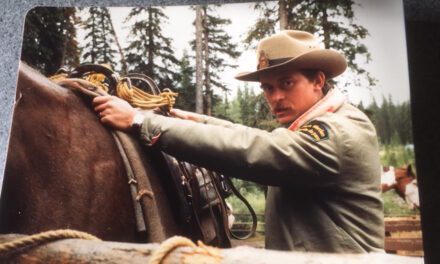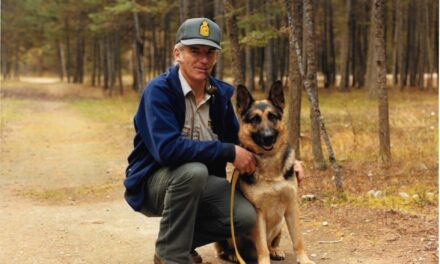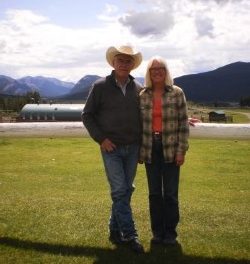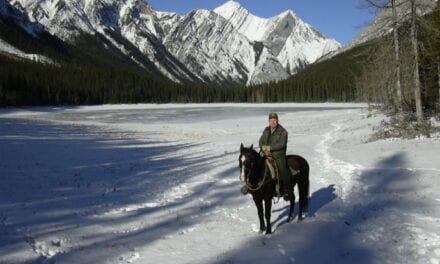(0:20:12) Marie – And you did. You felt like it was your own. We really did.
(0:20:20) John – So it was more fun being there at the Ya Ha Tinda than being out!
Was it just the Stoney (First Nation) band who would come in and hunt?
(0:20:33) Marie – There were other bands. Some from Edmonton and some from around Gleichen, the Blackfoot. There was a couple of bands even from BC who would come in. Sometimes they would phone ahead and ask you where the elk were. Or sometimes they wanted to know where the grizzlies were because some were scared of bears.
(0:21:00) John – The ones from Fort Assiniboine were from up north around Edmonton. They flock shot slaughtered all those elk that one time…We found dead elk after they had even left.
Were they just doing it for fun?
John: No, they were just shooting at the herd.
(0:21:22) Marie – Like maybe there were six people and in a big herd of elk they just shot at will. The elk would stampede and they’d get maybe two. So they would take those and be happy and leave. But they would actually hit three or four other ones. That was heartbreaking to find those elk lying there wasted. There was nothing really that you could do because they were gone before you could get license plates. That happened a couple of times.
Did you enjoy life at the Ya Ha Tinda?
(0:21:57) Marie – Oh absolutely!
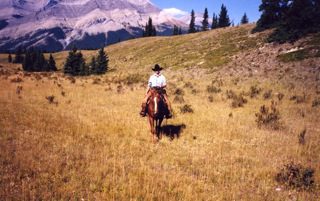
Marie, riding near West Lakes
Photo by John Nylund
(0:21:59) John – Another time the Indians shot a moose. It was in September and it was really warm out and they shot a moose. They had it in the campground…I forget how it all went, but we told them they had to get it out of there. They said they were getting out of there. But anyway Fish and Wildlife came up. Remember, Howie King came up and they got pretty tough with him. And he called for help. The RCMP told him to get out of there because they didn’t have enough staff down there to come up and help him.
(0:22:44) Marie – Having checked the subjects’ names on CPIC, the RCMP found they had a history of violence with weapons. But anyway Howie kind of bluffed his way through that and they did remove moose.
(0:22:57) John – But it was pretty intense there for a while.
(0:23:02) Marie – It is a long way for the RCMP officers to come up there. And at that time they were cutting them way back in manpower.
(0:23:12) John – There were a lot of people in the campground and we were just worried about the smell of the meat drawing bears in you know and somebody getting hurt.
(0:23:18) Marie – The potential was high for that.
Did they have treaty rights to come and hunt whenever?
(0:23:29) Marie – They had the right. They just had to respect the boundary of the road. There is that corridor that is a wildlife sanctuary along the road. It is so many meters from the center of the road. Some of them would think that they didn’t have to abide by that or by the restricted access to fenced pastures which were considered private. But they were in the minority, the ones that thought that they could do that. You would explain to them over and over again.
(0:23:58) John – Howie charged that one guy. Then they went to court, but I am not sure if they got them convicted.
(0:24:08) Marie – Those were the things you didn’t like…that you didn’t want to deal with. But they weren’t that often.
(0:24:17) John – That was the worst part about working out there. The trouble that other people caused you.
(0:24:24) Marie – With that campground there you got possibly a couple thousand people coming through in the course of six months, camping and riding. The majority abided by the rules one hundred percent. The campground had been in jeopardy in 1994. Parks Canada had closed it. Then this group of really dedicated campers formed the Friends of the Eastern Slopes and met with Perry and probably your dad (warden Keith Everts) at that time too maybe. He was in that era. They said, “Look what can we do to keep this campground open?” They formed a memorandum of understanding. They put the pit toilets in which could be cleaned out routinely. The campground had to be kept clean. They established a set of about 30 rules. Every year they improved on it and it has been great. They’ve done really well. But you get the minority in there that still do not want to abide by the rules. You just got to forget about those guys and appreciate the 99% that are doing what they are supposed to be doing…
What did you like best about working for Parks?
(0:26:04) John – That was probably the best. Was it your time at the Ya Ha Tinda?” But I liked them all, they were all good.
(0:26:08) Marie – They were all different.
(0:26:10) John – The days went fast most of the time. Especially in the wintertime when we started freighting hay to the backcountry and grooming the cross country ski trails. (This was when John was in Banff.)
(0:26:16) Marie – Yeah, you really liked that.
(0:26:18) John – That was interesting you know, with the skidoos hauling hay. I spent probably half the winter doing that every year.
Would you go too Marie?
(0:26:36) Marie – No I never had the opportunity. That was in the years that I was still working with the town. But the building of the log cabins…see your dad initiated that didn’t he? Keith was the motivator there to get all those cabins built. A few of us would go over and volunteer – peel logs, whatever… You couldn’t do it now under all the new laws, with all the labor code stuff. But we were there running chainsaws and Johnny was showing us how to do notches and Frank and your dad were there peeling logs. So it was kind of neat to be part of that construction process.
You built three cabins?
(0:27:43) John – Yeah, Palliser, Fish Lakes and Stoney Creek.
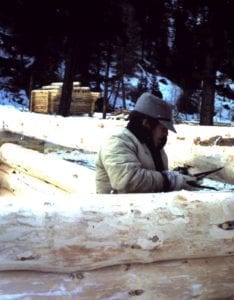
John scribing a log.

Frank Burstrom and John working on Palliser Cabin.
Photos courtesy of Don Mickle.
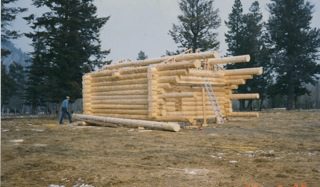
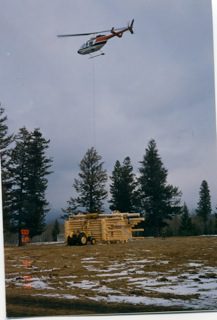
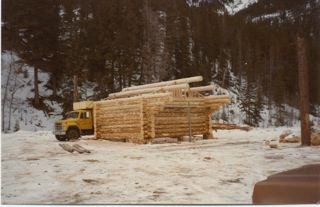
Building of Palliser Cabin.
Photos from Nylund family collection
